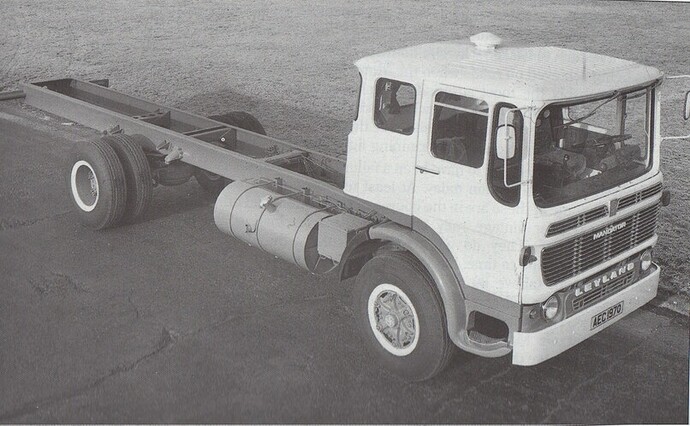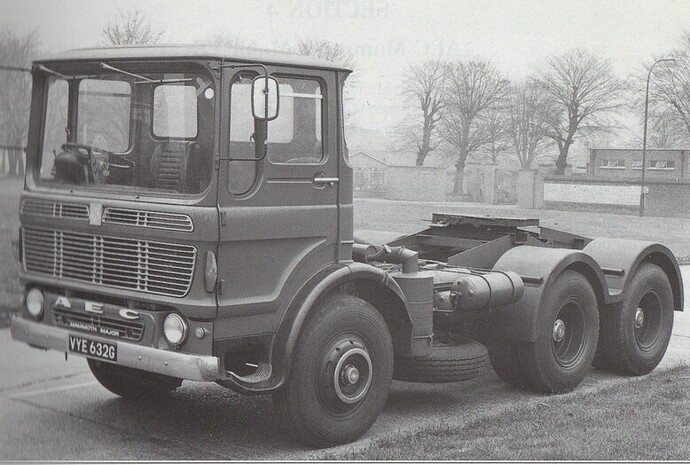I think the coach chassis is a Leyland
G’day,
Interesting to see the spec sheets for the Mammoth Major Six with a V8. There were some of those here in NZ,not sure how many but some did definatly make it out here. Sadly the motors would not have lasted very long due to heavy payloads and very hilly county.
Again over heating to the point of engines siezing was the problem. They would have been repowered after being rebuilt many times,straight six Detroit 671’s or V6 6v71’s were a popular re-power,with a 13 speed Road Ranger.
Last year I saw a high datum Madator 4x2 tractor with an origanal V8 in a yard waiting to be restored. A pretty rare truck,I was fairly excited to see it as it’s only the second V8 that I’ve seen. They were badged as ‘Leyland’ Mandator’s over here.
So how many high datum V8’s were produced?
How many of them were released in the UK?
How many MM6’s with V8’s were produced?
Were there any MM8’s with V8’s produced?
Wonder if that was getting a trailing dead axle yet to be fitted and a drag hook!
Jamie from what I’ve read (if we can believe it) there were about 40 High datum V8’s built, not many Mammoth Major’s with the engine and no 8 Wheelers (according to info), spec sheets only show the 4x2 Mandator and 6x4 Mammoth Major double drive with either single or double reduction rear hubs, although some Buses were supposed to have the engine too. AEC or should I say Leyland did buy a lot of the vehicles back from disgruntled buyers so they could have ended up anywhere or even scrapped, the Leyland Gas Turbine had a similar outcome once the project was ended, one has been restored to its former glory and a nice job too. Franky.
LB76:
0
Was that taken at Southall?
i believe it was mate by who tho i dont know
Ramone I’ve just been reading a copy of Vintage Roadscene (not a bad mag) from Jan 2011 that I hadn’t had a chance to read properly until now which would have answered most of your questions and others. The article is from a guy that worked for British Leyland, not sure in what capacity but he seems to have technical and sales info.
The article is about the V8 and then onto the Marathon with bits about why GUY and other parts of BL had their successes and failures. He first came across the Mandator V8 which was on trial by Western Transport of Bristol since August 1966 and two others were similarly on trial with Russell of Bathgate and Turners of Soham. He was told the drivers liked them and they left the high powered continental motors well behind on climbs and gave good fuel returns. If the local distributors were called out to these vehicles the boffins at Southall Experimental had to be notified. The new V8 was announced in May 1968 a few days after the new BLMC group had come into existence. We’ve already heard that AEC engineers were not happy about this as it was deemed too early (had been trialed for two years by then!).
Another factor which is quoted was that the new engine specs would be in Metric and so the original Imperial measurements would be converted, this meant a change in some tolerances and this was also blamed for component failure. Two sizes of engine were made, V8 740 and V8 800, which replaced the smaller engine in January 1969, the 800 at 272 bhp could also be Turbocharged to 350 bhp, at 32 Ton then plenty power for those times although they were required to cater for the 44 Ton gross weight being debated.
The Mammoth Major Six (as above) was proposed in 1968 powered with the V8 engine, although in the end only Tractor units were built and not goods chassis. Only Twenty of these were built with only one going into service in the UK (BRS 1969). As has been said previously about the problems with overheating and using the higher cab etc to combat this the main problem was the big end bearing failure and again this was countered by fitting new shells before 50,000 miles, which some companies did do and succesfully kept the vehicles on the road. About 360 vehicles were built whether this was just the Mandator or all the types it doesn’t say but only 60 went overseas. Hope this answers some of the questions and it seems the V8 wasn’t the failure always quoted and some companies run the vehicles for many years once they sussed the problems.
Cheers Franky.
Frankydobo:
Ramone I’ve just been reading a copy of Vintage Roadscene (not a bad mag) from Jan 2011 that I hadn’t had a chance to read properly until now which would have answered most of your questions and others. The article is from a guy that worked for British Leyland, not sure in what capacity but he seems to have technical and sales info.The article is about the V8 and then onto the Marathon with bits about why GUY and other parts of BL had their successes and failures. He first came across the Mandator V8 which was on trial by Western Transport of Bristol since August 1966 and two others were similarly on trial with Russell of Bathgate and Turners of Soham. He was told the drivers liked them and they left the high powered continental motors well behind on climbs and gave good fuel returns. If the local distributors were called out to these vehicles the boffins at Southall Experimental had to be notified. The new V8 was announced in May 1968 a few days after the new BLMC group had come into existence. We’ve already heard that AEC engineers were not happy about this as it was deemed too early (had been trialed for two years by then!).
Another factor which is quoted was that the new engine specs would be in Metric and so the original Imperial measurements would be converted, this meant a change in some tolerances and this was also blamed for component failure. Two sizes of engine were made, V8 740 and V8 800, which replaced the smaller engine in January 1969, the 800 at 272 bhp could also be Turbocharged to 350 bhp, at 32 Ton then plenty power for those times although they were required to cater for the 44 Ton gross weight being debated.
The Mammoth Major Six (as above) was proposed in 1968 powered with the V8 engine, although in the end only Tractor units were built and not goods chassis. Only Twenty of these were built with only one going into service in the UK (BRS 1969). As has been said previously about the problems with overheating and using the higher cab etc to combat this the main problem was the big end bearing failure and again this was countered by fitting new shells before 50,000 miles, which some companies did do and succesfully kept the vehicles on the road. About 360 vehicles were built whether this was just the Mandator or all the types it doesn’t say but only 60 went overseas. Hope this answers some of the questions and it seems the V8 wasn’t the failure always quoted and some companies run the vehicles for many years once they sussed the problems.
Cheers Franky.
Thanks for that i have read a few articles from the AEC society magazine about the engine but sometimes i think it maybe these enthusiasts looking through rose tinted glasses but this from an independent source gives a unbiased view
Ramone Wrote:
Thanks for that i have read a few articles from the AEC society magazine about the engine but sometimes i think it maybe these enthusiasts looking through rose tinted glasses but this from an independent source gives a unbiased view.
Yeah, he worked for Leyland too so wasn’t biased towards AEC, infact he didn’t know the V8 existed until he saw the trial vehicle then inquired about it, what he quoted came from others that operated or serviced them, suppose its history is like many others, some disliked a certain make while others thought they were the Bee’s knees according to the reliability, after service, expense etc that comes with every make. Interesting subject though, I was trying to work out about when I first saw the V8 and worked on the engine, must have been 1969 as the AEC distributor I worked for was the second job I had as an apprentice, having worked for about 18 Months before at a haulage company that ran mostly AEC’s and had one of the Mammoth Minor units, another interesting machine.
Cheers Franky.
You can still see one of these in action on the Southall Twilight DVD which has around 15 minutes colour film of the CM test from 1968, excellent music and commentary by Graham Edge which mentions some of what has been discussed here,an evocative film from Feb or March that year. There is a couple of longer Marathon promotion films after that. The V8 Mandator book by Graham Edge is also worth checking out.I’ve only ever spoke to one V8 driver and he held it in high regard the times he used it…
LB76:
0
Would that be a factory sleeper,i didn`t know they made 1 ,thats definitely Southall
Yes as far as i know it was a factory job, if i am wrong no doubt someone will let us know, got some more somewhere keep watching!
This thread as disturbed my cell and I can recall "Whewell’s " of Radcliffe running several AEC sleeper cabbed units and I think I was told the factory sleeper cab was slightly higher roofed incorporating a head board and there was a Belgium firm who ran quite a lot of them but I cannot say if any were powered by the V8.
cheers Johnnie
LB76:
0
The Leyland badge and lettering makes it look tacky if i owned it the first job would be to remove the badge engineering even though it looks like Leyland axles are fitted
A company called Bollekens seemed to be the leading cab manufacturer for AEC’s sold in Benelux countries.
Hiya…just a note…many people in the sixties were against there ever being a good V diesel engine
whenever mentioned it was like a black cloud as though a V engine would never happen.
I worked at ERF, at Sun Works and they fitted a V8 perkins in a unit and every one was saying it’ll
never work. Then came a Detriot (export motor steel cab 8 legger) thats no good, Perkins tested
a marathan with a Perkins in it, that had a bad report. The AEC got the same welcome thats no good
ERF fitted a dorman V6 people would,nt buy them. The early Maggi,s sounded like a bag of nails
then Scania seemed to be better but i think older people will agree they was still unsure about this
V engine idea in trucks.
John



